
A merchant ship, merchant vessel, trading vessel, or merchantman is a watercraft that transports cargo or carries passengers for hire. This is in contrast to pleasure craft, which are used for personal recreation, and naval ships, which are used for military purposes.

A bulk carrier or bulker is a merchant ship specially designed to transport unpackaged bulk cargo—such as grain, coal, ore, steel coils, and cement—in its cargo holds. Since the first specialized bulk carrier was built in 1852, economic forces have led to increased size and sophistication of these ships. Today's bulk carriers are specially designed to maximize capacity, safety, efficiency, and durability.

Lake freighters, or lakers, are bulk carrier vessels that operate on the Great Lakes of North America. These vessels are traditionally called boats, although classified as ships.

SS William A. Irvin is a lake freighter, named for William A. Irvin, that sailed as a bulk freighter on the Great Lakes as part US Steel's lake fleet. She was flagship of the company fleet from her launch in the depths of the Great Depression in 1938 until 1975 and then was a general workhorse of the fleet until her retirement in 1978.

A whaleback was a type of cargo steamship of unusual design, with a hull that continuously curved above the waterline from vertical to horizontal. When fully loaded, only the rounded portion of the hull could be seen above the waterline. With sides curved in towards the ends, it had a spoon bow and a very convex upper deck. It was formerly used on the Great Lakes of Canada and the United States, notably for carrying grain or ore. The sole surviving ship of the "whaleback" design is the SS Meteor, which is docked in Superior, Wisconsin, as a museum ship.

Algoma Mariner is a Canadian lake freighter delivered to Algoma Central on 31 May 2011. The bulk carrier was the first new Canadian-flagged vessel on the Great Lakes in 25 years. Algoma Mariner is a Seawaymax vessel, designed to carry dry bulk through the Saint Lawrence Seaway and Great Lakes. The vessel was constructed at the Chengxi Shipyard in China and is currently in service.
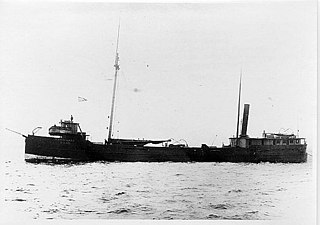
R. J. Hackett was a steamer built in 1869 in Cleveland, Ohio, by Peck & Masters. When the ship was first launched, both its wide cross-section and long midships hold were unconventional. The design's clear advantages in moving cargo through the inland lakes quickly resulted in many imitators.

The Mississagi was a lake freighter launched in 1943. Originally she was powered by a 2,500 horsepower (1,900 kW) triple-expansion steam engine. In 1985 her steam engines were replaced by a 4,500 horsepower (3,400 kW) diesel engine.

Algoma Equinox is a lake freighter and lead ship of her class built for Algoma Central, a Canadian shipping company. The vessel was built to a new design by Nantong Mingde Heavy Industries at their shipyard in Tongzhou, China in 2013. The ship entered service in December 2013, operating in the Great Lakes and Saint Lawrence Seaway.

The lake freighter MV Saginaw was launched as John J. Boland in 1953, the third vessel to bear that name. John J. Boland was owned and operated by the American Steamship Company and constructed by Manitowoc Shipbuilding Company at Manitowoc, Wisconsin. In 1999, the ship was sold to Lower Lakes Towing and renamed Saginaw. The ship is currently in service.

The SS St. Marys Challenger is a freight-carrying vessel operating on the North American Great Lakes built in 1906. Originally an ore boat, she spent most of her career as a cement carrier when much larger ore boats became common. After a 107-year-long working career as a self-propelled boat, she was converted into a barge and paired with the tug Prentiss Brown as an articulated tug-barge. Before conversion, she was the oldest operating self-propelled lake freighter on the Great Lakes, as well as being one of the last freight-carrying vessels on the Great Lakes to be powered by steam engines.

The Calumet was the second lake freighter of that name. The vessel was built in Detroit, Michigan, in 1929, by the Great Lakes Engineering Works. For her first 71 years she was operated by two subsidiaries of US Steel, the Pittsburgh Steamship Company, and the Bradley Transportation Company. She was christened the Myron C. Taylor after one of the directors of US Steel, Myron Charles Taylor.
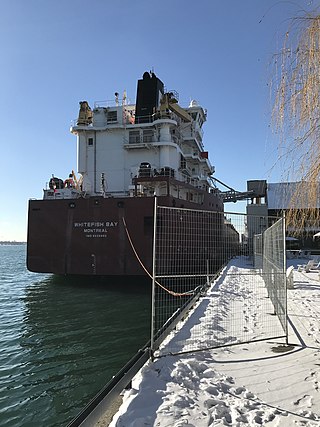
Whitefish Bay is a self-unloading lake freighter that entered service with Canada Steamship Lines (CSL) in 2013. Built in China, the vessel is the third of CSL's Trillium-class ships. Her sister ships are Baie Comeau, Baie St. Paul and Thunder Bay. Whitefish Bay is used primarily to transport goods on the North American Great Lakes and the St. Lawrence Seaway.

MV Edwin H. Gott is a very large diesel-powered lake freighter owned and operated by Great Lakes Fleet, Inc, a subsidiary of Canadian National Railway. This vessel was built in 1979 at Bay Shipbuilding Company, Sturgeon Bay, Wisconsin, and included self-unloading technology.
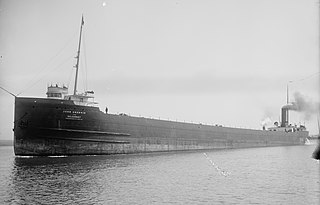
The John Sherwin was an American steel-hulled, propeller-driven Great Lakes freighter built in 1906 by the West Bay City Shipbuilding Company of Bay City, Michigan for service on the Great Lakes of North America. She was used to transport bulk cargoes such as coal, iron ore and grain. She served from her launching in 1906 to her scrapping in 1974, in Germany.

The SS Lakeland was an early steel-hulled Great Lakes freighter that sank on December 3, 1924, into 205 feet (62 m) of water on Lake Michigan near Sturgeon Bay, Door County, Wisconsin, United States, after she sprang a leak. On July 7, 2015, the wreck of the Lakeland was added to the National Register of Historic Places.
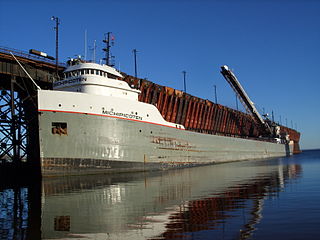
Michipicoten is a self-discharging lake freighter owned and operated by Canadian shipping firm Lower Lakes Towing. Michipicoten primarily hauls taconite from Marquette, Michigan, to the Algoma Steel Mill in Sault Ste. Marie, Ontario. It has a capacity of 22,300 tons, a speed of 12 knots (14 mph), and a length of 689 feet 6 inches (210.2 m).
Algoma Sault, which entered service in 2018, is the third freighter Algoma Central named after Sault Ste. Marie, Ontario. She is a self-unloading bulk carrier, built for carrying cargoes like ore, grain, or coal, on the North American Great Lakes and St. Lawrence Seaway. She is the seventh vessel of the Equinox class, and like her sister ships she was built in China.
Lake Frampton was a steam cargo ship built in 1918 by American Shipbuilding Company of Lorain for the United States Shipping Board (USSB) as part of the wartime shipbuilding program of the Emergency Fleet Corporation (EFC) to restore the nation's Merchant Marine. The vessel was employed in coastal trade during her career and collided with another steamer, SS Comus, and sank in July 1920 on one of her regular trips with a loss of two men.
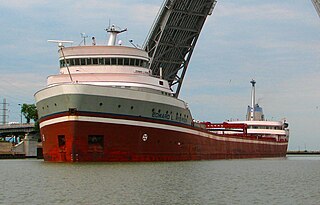
SS Edward L. Ryerson is a steel-hulled American Great Lakes freighter that entered service in 1960. Built between April 1959 and January 1960 for the Inland Steel Company, she was the third of the thirteen so-called 730-class of lake freighters, each of which shared the unofficial title of "Queen of the Lakes", as a result of their record-breaking length. She was not only the last steam-powered freighter built on the lakes but also the last one that was not a self-unloader. Since 2009, she has been in long-term layup in Superior, Wisconsin. She is one of only two American-owned straight deck lake freighters, the other being John Sherwin, built in 1958.



















